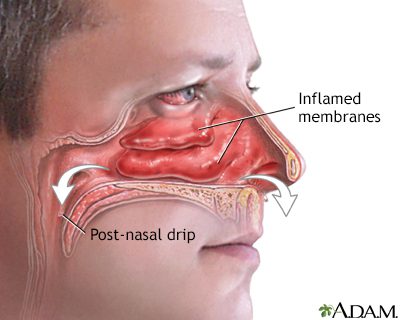Contents
Stuffy nose
How to recognize the symptom of a stuffy nose?
The symptom of a stuffy nose is the result of a contagious respiratory disorder like the common cold, for example. Its duration varies from 2 to 3 days. Children are the most affected, due to their immature immune system.
Sometimes called nasal congestion or obstruction, a stuffy nose is inflammation of the nasal lining. The drainage pipes are then narrowed and the mucus can no longer drain properly. Having a stuffy nose feels like you can’t breathe normally through your nose. A nasal obstruction is rarely isolated and is often accompanied by other complaints such as headaches or sneezing.
What are the causes of stuffy nose?
The causes of nasal congestion are mainly pathological:
- In most cases, the nose would become blocked as a result of nasopharyngitis which causes inflammation of the nasal cavity and pharynx (= musculo-membranous duct between the mouth and the esophagus). This inflammation causes the vessels to dilate. The mucous membrane swells under the effect of dilation and the nose becomes blocked.
- Sinusitis causes inflammation of the mucous membranes inside the sinuses and causes a discharge that remains inside the sinuses. It can be a source of nasal obstruction.
- Certain allergies can also congest the nose, such as hay fever, an allergy to pollen, dust, or even dust mites. In these cases, an inflammatory reaction then dilates the blood vessels.
- Another probable factor of nasal obstruction is the enlargement of the adenoids which consists of an increase in the volume of the tissue of the pharyngeal tonsil, placed behind the nasal cavity. There is then no room for the air to pass through the nose.
- More rarely, certain tumor pathologies such as ethmoid cancer (= median bone at the base of the skull), sinus cancer and the presence of polyps in the nose can be the cause of a blocked nose, usually unilaterally in these cases. precise, accompanied by bleeding and pain. The tissues then grow abnormally on the nasal mucous membranes and take up space, until they cause congestion.
Apart from these reasons, physical deformities can cause nasal obstruction, such as a deviated nasal septum or insufficiently rigid cartilage.
What are the consequences of a blocked nose?
Having a stuffy nose could cause otitis (= ear infection) due to the accumulation of secretions that enter the upper passages.
Nasal congestion can be a source of respiratory discomfort which means having to breathe through the mouth because the air no longer circulates properly from the nose to the lungs. To this discomfort can be added snoring and sleep apnea, affecting the quality of sleep.
Other consequences can occur, such as a feeling of heaviness in the head, discomfort or even trouble concentrating.
What are the solutions to relieve a stuffy nose?
There are many tips for dealing with a stuffy nose: use an air humidifier in an environment that is too dry, or drink plenty of water to hydrate the sinuses.
Some essential oils can be recommended in case of nasal congestion such as peppermint essential oil, cardamom essential oil or eucalyptus essential oil but also certain natural health products.
Taking antibiotics in case of infection may be advised. It is recommended to have the advice of a doctor beforehand.
Finally, also remember to contact your doctor to diagnose a possible disease such as sinusitis or, more serious, a tumor pathology, which may be responsible for nasal obstruction.
Read also :Our sheet on colds What to know about headache Information on nasopharyngitis Our sheet on sinusitis |










